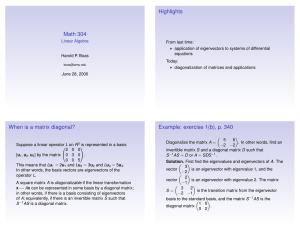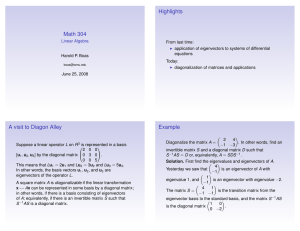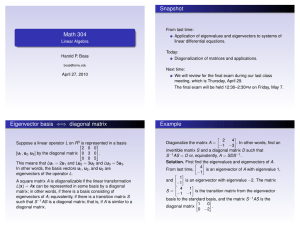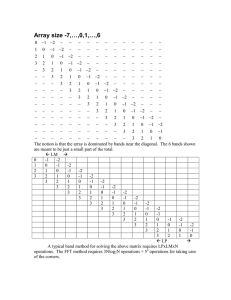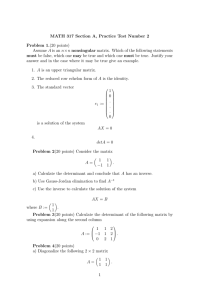Easy Perturbation Theory
advertisement
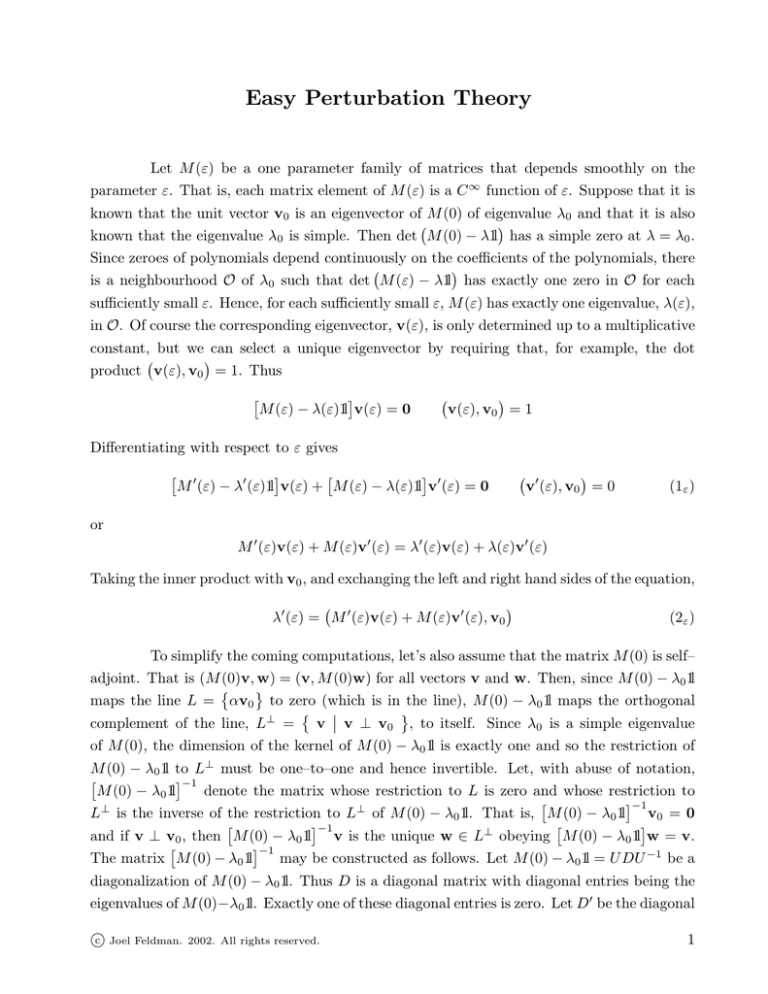
Easy Perturbation Theory Let M (ε) be a one parameter family of matrices that depends smoothly on the parameter ε. That is, each matrix element of M (ε) is a C ∞ function of ε. Suppose that it is known that the unit vector v0 is an eigenvector of M (0) of eigenvalue λ0 and that it is also known that the eigenvalue λ0 is simple. Then det M (0) − λ1l has a simple zero at λ = λ0 . Since zeroes of polynomials depend continuously on the coefficients of the polynomials, there is a neighbourhood O of λ0 such that det M (ε) − λ1l has exactly one zero in O for each sufficiently small ε. Hence, for each sufficiently small ε, M (ε) has exactly one eigenvalue, λ(ε), in O. Of course the corresponding eigenvector, v(ε), is only determined up to a multiplicative constant, but we can select a unique eigenvector by requiring that, for example, the dot product v(ε), v0 = 1. Thus M (ε) − λ(ε)1l v(ε) = 0 v(ε), v0 = 1 Differentiating with respect to ε gives M ′ (ε) − λ′ (ε)1l v(ε) + M (ε) − λ(ε)1l v′ (ε) = 0 v′ (ε), v0 = 0 (1ε ) or M ′ (ε)v(ε) + M (ε)v′ (ε) = λ′ (ε)v(ε) + λ(ε)v′ (ε) Taking the inner product with v0 , and exchanging the left and right hand sides of the equation, λ′ (ε) = M ′ (ε)v(ε) + M (ε)v′ (ε), v0 (2ε ) To simplify the coming computations, let’s also assume that the matrix M (0) is self– adjoint. That is (M (0)v, w) = (v, M (0)w) for all vectors v and w. Then, since M (0) − λ0 1l maps the line L = αv0 to zero (which is in the line), M (0) − λ0 1l maps the orthogonal complement of the line, L⊥ = v v ⊥ v0 , to itself. Since λ0 is a simple eigenvalue of M (0), the dimension of the kernel of M (0) − λ0 1l is exactly one and so the restriction of M (0) − λ0 1l to L⊥ must be one–to–one and hence invertible. Let, with abuse of notation, −1 M (0) − λ0 1l denote the matrix whose restriction to L is zero and whose restriction to −1 ⊥ L is the inverse of the restriction to L⊥ of M (0) − λ0 1l. That is, M (0) − λ0 1l v0 = 0 −1 and if v ⊥ v0 , then M (0) − λ0 1l v is the unique w ∈ L⊥ obeying M (0) − λ0 1l w = v. −1 The matrix M (0) − λ0 1l may be constructed as follows. Let M (0) − λ0 1l = U DU −1 be a diagonalization of M (0) − λ0 1l. Thus D is a diagonal matrix with diagonal entries being the eigenvalues of M (0)−λ0 1l. Exactly one of these diagonal entries is zero. Let D′ be the diagonal c Joel Feldman. 2002. All rights reserved. 1 matrix with each diagonal entry being the inverse of the corresponding diagonal entry of D, −1 except that the zero diagonal entry of D is left as is. Then M (0) − λ0 1l = U D′ U −1 . Now, setting ε = 0 in (2ε ) and using M (0)v′ (0), v0 = v′ (0), M (0)v0 = v′ (0), λ0 v0 = λ0 v′ (0), v0 = 0 gives λ′ (0) = M ′ (0)v0 , v0 (20 ) Setting ε = 0 in (1ε ) and subbing back in (20 ) gives M (0) − λ(0)1l v′ (0) = −M ′ (0)v0 + λ′ (0)v0 = −M ′ (0)v0 + M ′ (0)v0 , v0 v0 The right hand side is exactly the projection of −M ′ (0)v0 on L⊥ and, in particular, is in L⊥ . Since v′ (0), v0 = 0, v′ (0) is itself in L⊥ and −1 ′ −1 v′ (0) = − M (0)−λ(0)1l M (0)v0 + M ′ (0)v0 , v0 v0 = − M (0)−λ(0)1l M ′ (0)v0 (10 ) −1 Recall that, by definition, M (0) − λ(0)1l v0 = 0. We now know λ′ (0) and v′ (0). Differentiating (2ε ) with respect to ε gives λ′′ (ε) = M ′′ (ε)v(ε) + 2M ′ (ε)v′ (ε) + M (ε)v′′ (ε), v0 Setting ε = 0 and using M (0)v′′ (0), v0 = v′′ (0), M (0)v0 = v′′ (0), λ0 v0 = λ0 v′′ (0), v0 = 0 (the derivative of (1ε ) includes v′′ (ε), v0 = 0) and (10 ) gives λ′′ (0) = M ′′ (0)v0 + 2M ′ (0)v′ (0), v0 −1 = M ′′ (0)v0 , v0 − 2 M ′ (0) M (0) − λ(0)1l M ′ (0)v0 , v0 Continuing in this way, one can compute all derivatives, λ(n) (0) and v(n) (0), of λ(ε) amd v(ε) at ε = 0. If M (ε) is analytic in ε at ε = 0, the same is true for λ(ε) and v(ε) and the computed derivatives determine them. c Joel Feldman. 2002. All rights reserved. 2

